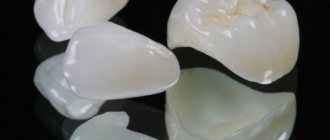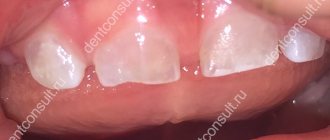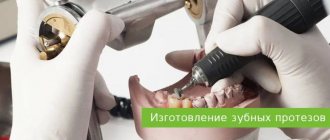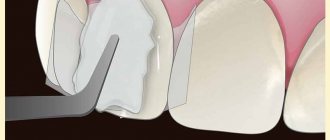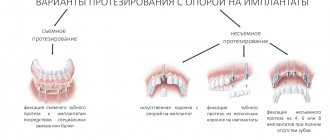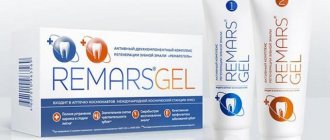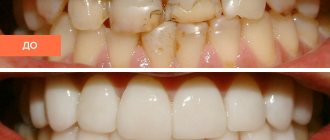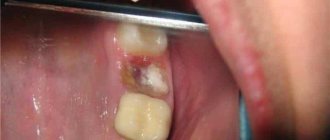Restoration of tooth enamel is a procedure that ensures the regeneration of the damaged dentin surface.
The following causes of enamel damage are identified:
- genetic predisposition;
- physiological state of the body (presence of internal diseases that negatively affect tooth enamel);
- lack of essential substances and minerals in the diet;
- anatomical features of the structure of teeth;
- excessive consumption of citrus fruits;
- brushing your teeth with a hard brush;
- eating large amounts of sweet, sour and very hot foods;
- abuse of carbonated drinks and alcohol;
- using toothpaste or abrasive powder.
Dentists on Rimskaya
Gneusheva Elena Viktorovna
Dentist-orthodontist, pediatric orthodontist
Experience: 20 years
★ For more than 13 years she worked at the Moscow State Medical University at the Department of Orthodontics and Children's Prosthetics, Ph.D.
Gorokhova Inga Vitalievna
Dentist-therapist
Experience: 14 years of total experience
★ Expertise in restorative dentistry to make your teeth shine
Konstantinov Oleg Nikolaevich
Dental surgeon
Experience: 25 years
★ Virtuoso of painless treatment. Patients fall asleep in the doctor's chair
Nikolaychuk Anna Vladimirovna
Chief physician, dentist-therapist
Experience: 13 years
★ Chief specialist in the treatment of toothache. Masterfully deals with problems quickly and permanently
Frolova Alexandra Ivanovna
Dentist-therapist
Experience: 25 years
★ A brilliant specialist with many years of experience as a manager in public dentistry
Read also
What is dental restoration
If the aesthetic properties of teeth are lost, a person experiences certain discomfort.
Who is an orthopedic dentist?
Orthopedics in dentistry is a branch of medicine that deals with the restoration of teeth using all modern prosthetic techniques.
Causes of tooth enamel destruction
Damaged tooth enamel can even lead to tooth decay because it does not regenerate. The causes of destruction can be completely different, but they can be combined into several groups, because of which patients are increasingly turning to the clinic.
- Bad habits and lack of proper nutrition. It has long been proven that cigarettes, alcoholic drinks and foods high in sugar have a detrimental effect not only on tooth enamel, but also on the entire body as a whole. In the absence of a balanced diet, disruption of the gastrointestinal tract also occurs, leading to a failure of the acid-base balance. The stomach acid that is released can destroy tooth enamel.
- Sugary carbonated water and excessive consumption of citrus fruits.
- Frequent temperature changes when consuming food and drinks.
- Mechanical damage to the oral cavity, which also includes malocclusion, grinding of teeth, and incorrect treatment process.
- Genetic predisposition.
- Metabolic disorder.
- Age-related changes that contribute to an increase in the distance between teeth.
- Bruxism.
- Childbearing and lactation period.
Specialists working in dentistry will help you find out the exact cause of tooth enamel destruction. The earlier the treatment, the greater the likelihood that it will be possible to avoid the development of severe consequences for the oral cavity, teeth and gums.
Reasons for dental restoration
There can be many problems for requests, but let’s highlight the main ones:
- chipped tooth edge;
- cracks;
- cracks and gaps between teeth (trema, diastema);
- anatomical features - narrow teeth, wedge-shaped defect;
- tooth decay;
- the enamel color is dark or uneven;
- inability to place a filling due to a large cavity and lack of tissue.
That is, dissatisfaction with the symmetry, color, location or results of tooth trauma.
Therapeutic and dental treatment in the clinic
In most cases, home methods for restoring the color of tooth enamel give only a small effect, which lasts only for a while. To get maximum results, it is recommended to consult a doctor. How much does the procedure for restoring tooth enamel cost? The price varies depending on the clinic, the range of necessary measures, and the territorial location (the cost in Moscow and Tambov will vary significantly).
How can the dental clinic help?
- Fluoride varnish. It is prescribed if there is slight sensitivity of the crowns, as well as as preventive measures in childhood and adolescence. In comparison with other ways to protect tooth enamel, this remedy is considered the most inexpensive, but provides significant strengthening of teeth. The essence of the technique is that the dentist applies a protective agent to the crowns, where a protective layer is subsequently formed, due to which fluoride is released into the tissue.
- Remineralization. The key difference from fluoride varnish is that when it is used, the enamel is saturated with a whole complex, which, in addition to fluorine, also includes calcium ions. Thanks to additional preparations, tooth enamel is quickly restored and thickened.
- Deep fluoridation. This technique is based on covering all teeth with varnish, which fills even small cracks in the enamel. This technique allows for quick recovery and reduces the risk of caries formation by 2 times. In addition, the condition of the teeth improves, soft tissue restoration is noted, and hardness increases.
- Filling. You should not think that this is a standard procedure, because during restoration this happens in several stages. The dentist independently determines how many layers will need to be applied to the tooth in order to cover all the damage and cracks present on the surface.
Restoring the enamel layer of a tooth is affordable for every person, given that modern dentistry provides a wider range of available services.
Direct and indirect dental restoration
Direct and indirect dental restoration are methods of restoring hard dental tissues. The restoration is performed taking into account the anatomy, morphology and functionality of the tooth. The main differences between these methods are the material from which the future restoration will be made, the technique of execution and, as a result, strength and aesthetic appearance.
So when performing the direct method
For restorations, light-curing composite materials are used, and for
indirect
restorations, all-ceramic or all-zirconium blocks are used.
The advantages of ceramics over composites are obvious. Numerous studies have shown that ceramics are not prone to staining, abrasion, do not absorb odor and prevent the formation of plaque due to its perfectly smooth surface.
The time required for direct cosmetic restoration of teeth is a little from 1 to 2 hours, and the production time for indirect, ceramic restoration of the tooth shape is several days.
Modern methods of treatment
The technological advancement of processes does not stop, so modern medicine, improving, is ready to offer innovative methods that can solve the problems of pathological abrasion of tooth enamel, eliminate cracks in the shortest possible time and quickly level the surface of the crown.
These include, for example, enamel implantation, which can restore even severely damaged teeth. A qualified clinic specialist creates a material that, in its external characteristics, is indistinguishable from natural enamel. With its help, an organic replacement of the destroyed part of the tooth occurs.
Using this method, you can cosmetically correct a defective bite. If a person takes proper care of their oral cavity, such an implant will last for decades.
Dental onlays deserve special attention, allowing the client to achieve the effect of the famous Hollywood smile. They are divided into two types:
- Lumineers
- Veneers
The key difference between them is the fact that when placing lumineers, teeth are not ground down, and in terms of external characteristics they are much thinner. Doctors recommend resorting to this technique if all other methods have already been tried.
It is worth noting that, despite the fact that strong and durable porcelain is used in the manufacture of onlays, even with careful care, the products become unusable over time. The average length of their service is approximately 15 years.
Among the advantages, of course, stands out the ability to completely cover all existing defects of tooth enamel, hide or clearly reduce the dental space, as well as mask the incorrect position of the tooth in the socket.
Veneers
A veneer is a microprosthesis in the form of a thin plate made of ceramic or composite material. The front part (front section) is covered with veneers. They correct its appearance: hide stains or erosion of the enamel, hide darkening or staining, remove chips and cracks, etc. By the way, the smile of many Hollywood actors is hidden behind veneers.
Veneers are installed in 2 stages:
- They grind the tooth, then make an impression of it. Plaster molds are made from the cast, in which the microprosthesis is baked in an oven. It takes several days to manufacture, so a temporary composite veneer is installed on the treated surface to protect the tissue from exposure to an aggressive environment.
- They try on the veneer. If it fits perfectly, it is literally glued on; if not, it is returned to the laboratory for revision. An incorrectly selected veneer will only make the situation worse.
Like dental crowns, veneers hide visual imperfections, but they require less grinding than crowns and are significantly less expensive. For cosmetic purposes, it is better to use veneers, this way you will protect the tooth from unnecessary procedures.
Treatment and restoration of enamel at home
If there is minor damage to the teeth and approval after consultation with a specialist at a dental clinic, you can resort to traditional methods. However, when using them, you should understand that the enamel is easily damaged and cannot be restored without professional help. When starting treatment with traditional methods, it is important to understand that there will be no quick results, this is a long process.
What recipes will help in the process of restoring tooth enamel?
- Baking soda. It can be used no more than once a week, because the substance has too high a degree of purification.
- White lemon pulp. This method is considered the most productive, but it must be used for a maximum of 7 days. The soft skin of the lemon will need to be used to wipe the enamel of the teeth.
- An ideal companion to help with such a sensitive issue is tea tree oil. To achieve maximum effect, you only need a couple of drops diluted in a glass of water. The resulting liquid should be rinsed in the mouth. In addition to strengthening and restoring enamel, the oil helps get rid of pathogenic bacteria and bad breath. If you regularly use tea tree oil, your teeth will be protected from periodontitis and caries.
- Fruits. As surprising as it may be, strawberries also have a restorative function. You will need to mash the berries well, apply to your teeth and hold for several minutes. After the procedure, you will definitely need to thoroughly brush your teeth.
- Activated carbon. With its help, you can whiten your teeth and remove unwanted plaque. To create an ointment, you will need a couple of charcoal tablets, which are then rubbed into the enamel. After 5 minutes, it is important to rinse your mouth thoroughly. You should not conduct such experiments more than twice a week.
- Sea salt. In this case, additional ingredients will be required, in the form of 4 tablespoons of salt and half a glass of water. You need to rinse your mouth with the solution for a month. You can also rub dry sea salt with a brush, but before doing this, it is recommended to grind it.
Special gels and toothpastes deserve special attention. You should not rely on advertising that promotes the “best” pasta. In fact, each of them is focused on solving a specific problem. However, when purchasing any of them, you should definitely consult with your doctor.
Prevention
When trying to keep your teeth enamel in order, experts also advise reviewing your diet and not forgetting about preventive measures.
By introducing certain products into your regular menu on an ongoing basis, you can strengthen both your teeth and gums.
- Milk and dairy products. They help replenish the body’s small amounts of calcium, phosphorus, protein and vitamins such as A, D, C, B.
- Fish and seafood that contain phosphorus, iodine, fluorine and calcium.
- Coconut oil. Its action will help get rid of fungal infection and allow calcium and magnesium to be properly absorbed.
- Greens, in particular broccoli, which contain bactericides that help protect against periodontal disease and caries.
Among other recommendations, it is worth noting that a good prevention of damage to tooth enamel is regular gum massage, which increases blood flow. To achieve maximum effect, you will need to perform massage actions 3-4 times a day, after washing your hands well. To ensure that the massage is not in vain, it is advisable to reduce the consumption of too hard foods, because this can cause mechanical damage.
In addition to including foods in your daily diet, it is also worth excluding something. First of all, these should be carbonated drinks with a large amount of caffeine. Also, do not abuse alcohol and reduce, or even give up, cigarettes. It is necessary to visit the dentist twice a year; consultation and prevention will help protect teeth and enamel from destruction.

